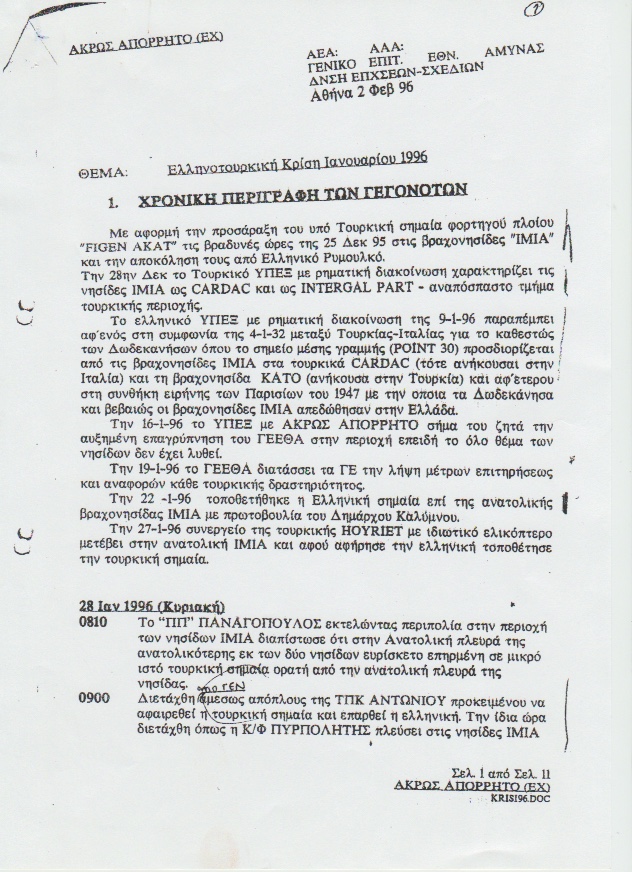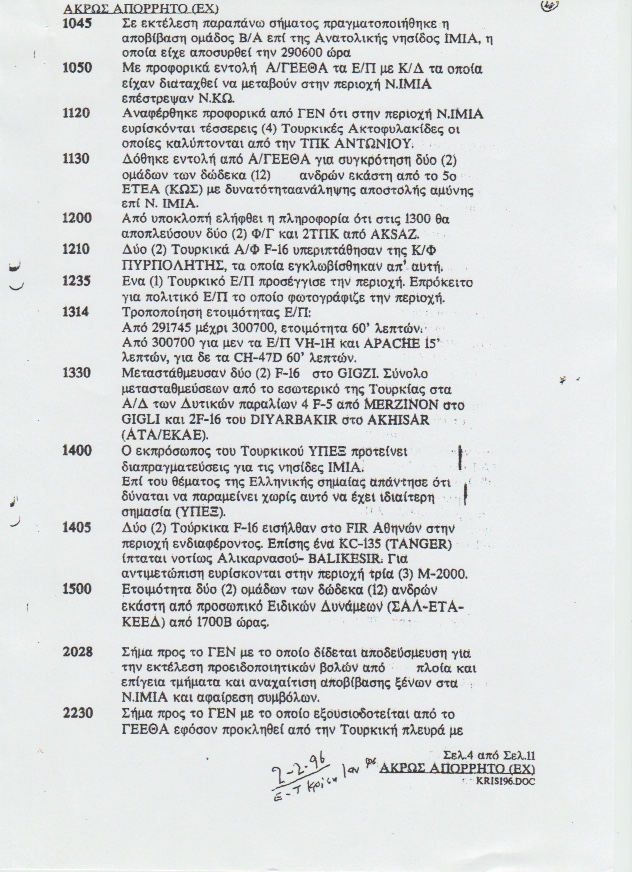
Top secret document of the General Staff of National Defense, drawn up on February 2, 1996, the day after night Imion, describes minute by minute the development of the crisis and illuminates the faces, decisions and events in those critical hours. The crisis began to take on serious dimensions on January 22, 1996, the same day that Kostas Simitis was elected Prime Minister by the PASOK Parliamentary Group.
On this day, the mayor of Kalymnos, Dimitris Diakomichalis, reacting to the information that the Turkish Foreign Ministry considers Imia to be Turkish, places the Greek flag on the eastern island of Imia. On Saturday, January 27, Hurriyet Turkish journalists replace it with the Turkish flag. On Sunday, January 28 at 10:00 am, the high-speed patrol car “Antonio” removes the Turkish flag and restores the “municipal” Greek flag – without being ordered to do so. The order of Defense Minister Gerasimos Arsenis was simply to remove the Turkish flag. In addition, there are no flags on the rocky islands. The Ministry of Defense understands that the new Greek flag has been installed by the Armed Forces, so now the Armed Forces will have to transfer the flag into custody. According to a secret document, at 8:50 pm that Sunday, seven divers landed in the eastern part of Imia to guard the flag. At six in the morning on Monday, January 29, they again transferred to the gunboat Pirpolitis and returned to Kalymnos. At 08:25 GETHA commander Admiral Christos Limberis ordered the GEN to land the divers again at Imia, which was done at 10:45.
Critical 24 hours
In the early morning of Tuesday, January 30, at 04:27, the GEN sends the Navarino frigate to Imia. At 08.55, a signal was received from the Main Directorate of Civil Defense that the head of the Civil Defense Directorate, by decision of the Minister of Defense, took over the operational command of the 1st Army, ASDEN, reserves of the State Emergency Service (Special Forces Units), combat units of the Navy and ATA. According to Limberis, the Turks may land at Kalolymnos. And so the choice is made to settle the commandos on this island (and not on western Imia). Thus, at 2:56 p.m., it is ordered to increase surveillance of Kalolymnos (Gaidouronisi), an island one nautical mile west of Imia. At 15.20 two helicopters with 12 men take off from Kos and arrive on the island at 15.40. Late at night, in less than an hour, Limberis puts the entire Armed Forces on alert. At 23.20, the head of the GITHA decides to disperse units of Evros and the Eastern Aegean Islands in new positions, which provide additional opportunities for combat missions. At 2341 the signal was given to the entire Greek fleet to sail. At 23.48, an order comes to the special forces to carry out top-secret plans (“Erins” and “Circuses”). At 23.57 a signal was given to bring the Air Force into battle order.
In order to better illuminate the chronology of the hostilities detailed in the secret GEETHA document, we must recall the political initiatives that took place in parallel that night. Close to midnight and after the completion of the parliamentary debate on a vote of confidence in the new government of Simitis, a meeting of the government committee is convened in the office of the Prime Minister in Parliament, which is attended by: Akis Tsochatzopoulos, Theodoros Pangalos, Gerasimos Arsenis, Yiannos Papantoniou, Dimitris Reppas and Admiral Christos Limberis with the General Cabinet Secretary Thassos Mantelis and advisers to the Prime Minister Nikos Temelis and Dimitris Karaitidis are present. Simitis requests information. Liperis speaks first, laying out maps of the Aegean on a conference table. He claims that Greece has the largest forces in the region and asks for clarification of the rules of engagement for bombarding rocky islands if necessary or for ramming a Turkish ship. Limberis, as he mentioned in his book March into Troubled Seas (Quality Publishing House, 1999), supported a “first strike strategy.” He explained that Greece could deliver a decisive blow to Turkey that would nullify its plans for the Aegean, even if the expected Turkish response would also result in some Greek casualties. Between the dilemma of “bilateral Aegean talks or war, Greece can choose the latter if it wants to, but end up in the former,” Simitis explains, because there will be negotiations after the conflict, whatever the outcome of the conflict. Further, according to the book by Simitis “Politics for Creative Greece” (Polis Publishing House, 2005), the following dialogue took place:
Simitis: Is the western islet of Imia protected?
Limberis: Of course, guarded.
Simitis: Are there men on the island?
Limberis: No, but the ships around Imia are arranged in such a way that not a single Turkish ship can pass.
At 23.48, the special forces received an order to implement top secret plans. At 23.57 a signal was given to bring the Air Force into battle order.
Around this time, the crisis escalates. According to a confidential GEETHA document, at one in the morning. On the night of Tuesday to Wednesday, January 31, information was received from a highly reliable source about an imminent enemy attack. The GITA chief orders the general to target all Turkish ships.
At 01:35, two Turkish Black Hawk helicopters fly over Imiya at the same time that the Yavuz frigate is 500 meters from the islets. Ten minutes later, the head of GEN, apparently in consultation with the head of GEETHA, ordered rockets fired at the helicopters and if they tried to land, shoot them down. Eight minutes later, the Turks moved the Yavuz and helicopters to the east. But at the same time, information is coming in that a Turkish helicopter may try to land in Pharmakonisi. On October 2, Deputy Secretary of National Defense, Flight Commander Nikos Kouri, who was at the Pentagon Operations Center, gave a verbal order that if the helicopter tried to land, it should be shot down. Five minutes later, the order was changed so that only people exiting the helicopter were visible. In fact, it was a distraction for the Turks. The Greeks thought that the Turks were trying to attack, but with this operation of the alleged attack, the Turks covered the landing of their commandos in western Imia, without the Greek side noticing!
Around the same time, Greek commandos are trying to land in the hitherto unguarded western Imia, and no one knows that Turkish commandos have just landed. The Greeks were delayed because their radios had no batteries. They were taken by their counterparts from eastern Imia as a reserve. Therefore, the commandos planned to go to eastern Imia first to pick them up and then go to western Imia. By the time they did, rumors had spread that Turkish commandos had landed in the western part of Imia. But who gave the order to the Greek commandos to go to the western part of Imia? Until that time, it was assumed that a line of seven ships would suffice. It is possible that Liberis gave the order because he was concerned about a previous dialogue with the prime minister about “whether the islet is secure”. Possibly Deputy Defense Minister Nikos Kouris. Finally, the landing of the Greeks was cancelled. The Turks caught up first. But how did they know about it in Athens? From the Athens News Agency (APE). In Turkey, on live TV at approximately 3.30 Greek time, the Turkish Ministry of Foreign Affairs announced that “the peaceful occupation by the Turks of the western part of Imia has taken place.” The announcement was broadcast by the Athens News Agency by telegram from Ankara. An APE representative calls Dimitris Reppas, who was the Minister of Press and participated in the meeting in Parliament, but at that moment he left the room. He enters again and angrily announces: “The Turks say they have been on Imia for two hours!”



Difficult decisions
Simitis asks Limberis if this could be true. At first, Liberis replies that the news is definitely inaccurate. Simitis asks if he can use the helicopter to confirm what’s going on and Limberis says no. Simitis convenes KYSEA and its members start arriving from 04.10. According to a secret GEETHA document, at 04.25 the information about the occupation of the western part of Imia was also confirmed by the Greek side, in particular, by the Supreme Military Directorate of the Interior and the Islands (ASDEN) and GEN. The confirmation was a Greek helicopter that was launched at 04.13 by the Navarino frigate, which, as Simitis emphasizes in his book, was done without the knowledge of KYSEA. At 0440, Deputy Secretary of National Defense Nikos Kouris of the Pentagon Operations Center gives the order to prepare a plan of operation for the recapture of the western island of Imia by special forces. At a meeting in parliament, Limberis explains that the preparation of this operation will take about 6 hours. Simitis notes that such an operation “cannot be done in broad daylight”. Oh, it’s not possible at all! In the meantime, the helicopter, returning one nautical mile north of Imia, reported a major warning without indicating a specific malfunction. Communication with the ship was lost and shortly thereafter it disappeared from radar at 0449 hours. The information reached KYSEA, but, according to Simitis, it was initially denied. It was alleged that the helicopter had run aground or was in danger.
At a time when Greeks and Turks were on the two islets of Imia, the dilemma was a new escalation of the bombing crisis, which would end in negotiations with wider doubts about Greek sovereign rights, or with the withdrawal of all forces brokered by Holbrooke. Simitis is asking Pagalos to reach an agreement with US Assistant Secretary of State for European Affairs Richard Holbrook, who that night—and following a midnight phone call between Simitis and Clinton—assumed the role of mediator. On the 6th, the Pagaloo-Holbrook agreement was reached for a simultaneous withdrawal with the wording “no ships, no troops, no flags”.
The meeting ends, but Simitis remains in the Prime Minister’s office. At 7 am, Mega informs him that the helicopter has crashed. He calls Arseniy, who confirms the information and tells him that the previous rejection was due to a mistake. According to a secret document, at 07:25 general military orders for high alert and the lifting of all alert measures began, while the search for the crew was carried out. As stated in another Navy document: “The finds at the crash site of the helicopter were scattered, and the floats were at a distance of about 30 meters from each other. This means that the helicopter hit the sea at speed and did not even enter the process of self-rotation (forced grounding), because then, even if this failed, the helicopter would not fall apart. This reinforces the idea of hallucinations, disorientation combined with damage to the main systems of the helicopter, whatever it is. What is written in the press about interference is completely untrue, since engines, dynamic parts of the helicopter (shafts, rotors), basic flight instruments (barometric altitude, direction indicator, attitude indicator and speedometer) are not affected by interference. “
Source: Kathimerini
Anna White is a journalist at 247 News Reel, where she writes on world news and current events. She is known for her insightful analysis and compelling storytelling. Anna’s articles have been widely read and shared, earning her a reputation as a talented and respected journalist. She delivers in-depth and accurate understanding of the world’s most pressing issues.